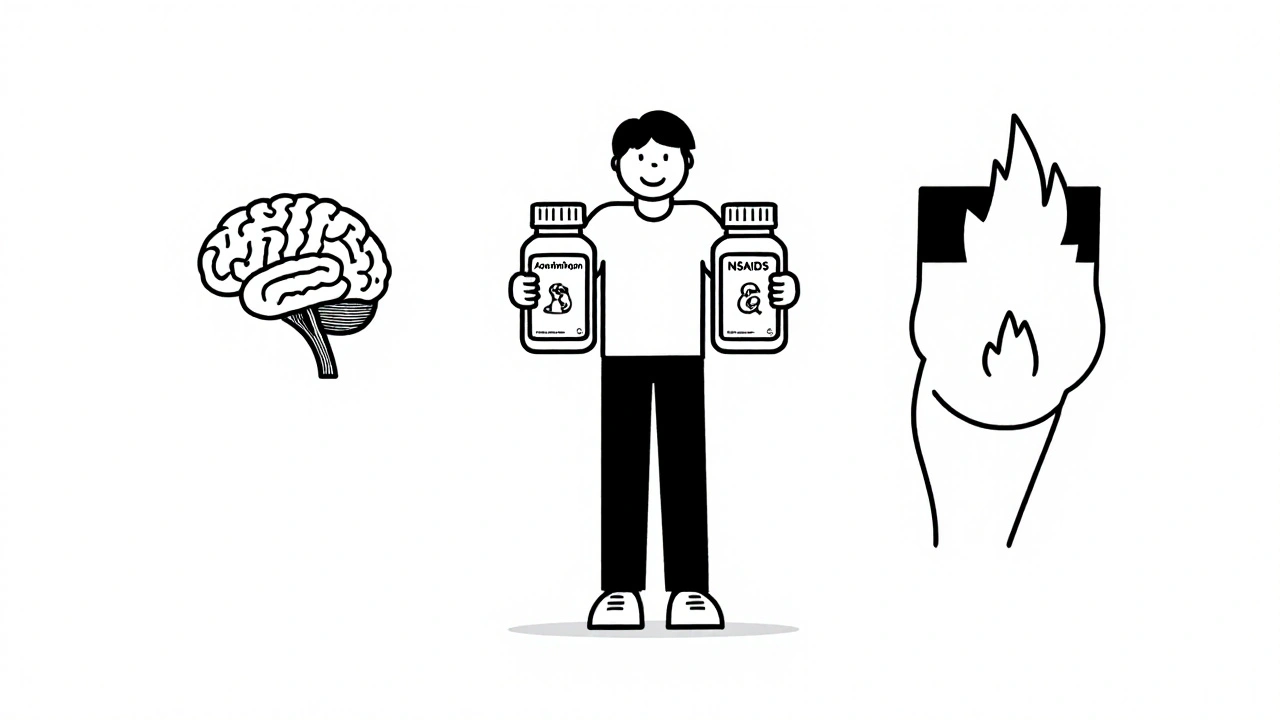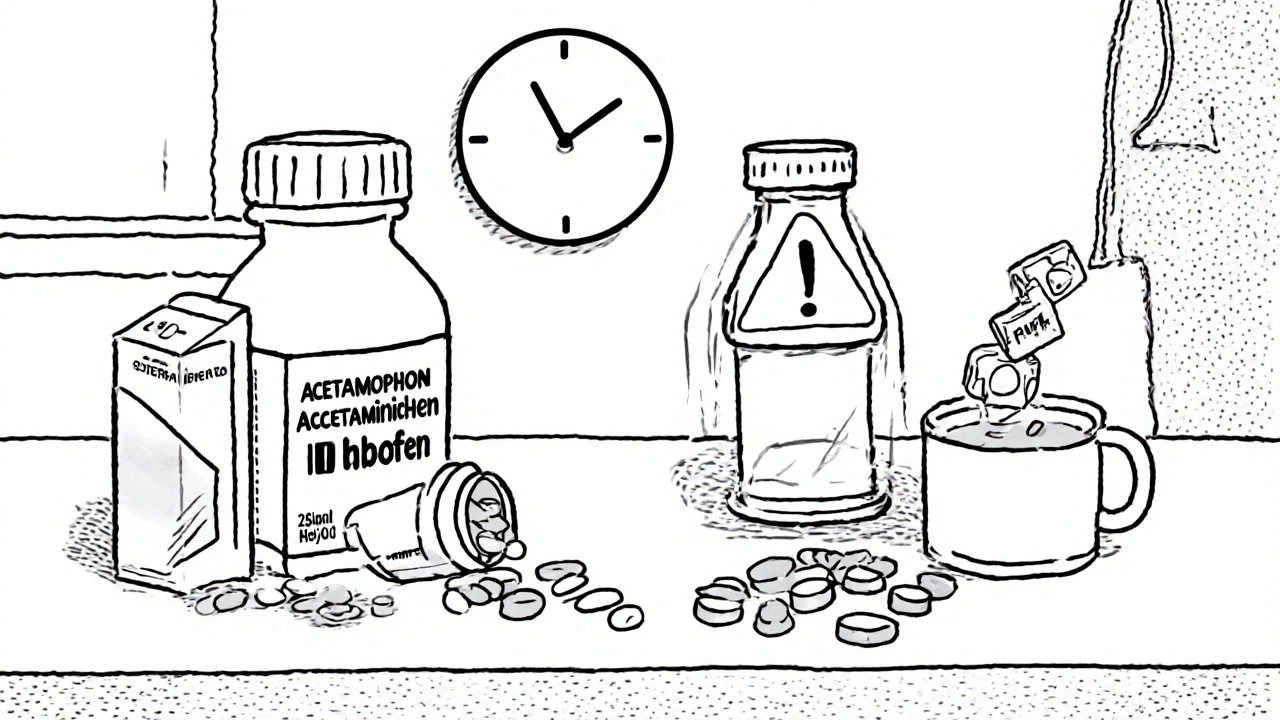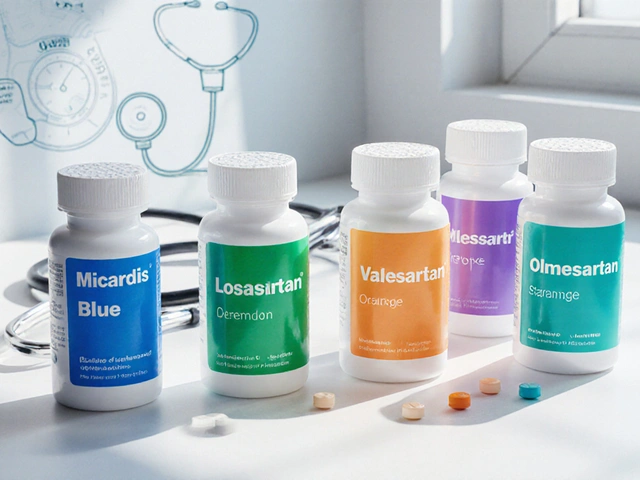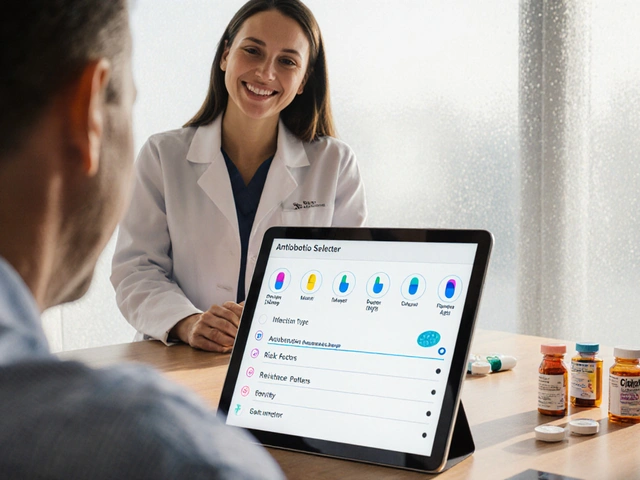
When you have a headache, sore muscles, or a fever, you reach for the medicine cabinet. But not all OTC pain relievers are the same. Two main types dominate the shelves: acetaminophen and NSAIDs. Knowing which one to pick - and when - can mean the difference between quick relief and avoidable side effects.
What’s the real difference between acetaminophen and NSAIDs?
Acetaminophen (sold as Tylenol, Panadol, and many generics) and NSAIDs (like ibuprofen, naproxen, and aspirin) both reduce pain and fever. But that’s where the similarity ends.
Acetaminophen works mostly in your brain and spinal cord. It doesn’t touch inflammation. If you have a swollen knee from arthritis, acetaminophen might ease the pain a little, but it won’t reduce the swelling. That’s where NSAIDs come in. They block enzymes called COX-1 and COX-2 throughout your body, cutting down on prostaglandins - the chemicals that cause pain, fever, and swelling. So if you’ve got a sprained ankle, a bad case of period cramps, or inflamed joints, NSAIDs work better.
Harvard Health says it plainly: “Only NSAIDs can reduce inflammation.” That’s not a small detail. It’s the deciding factor for many types of pain.
Which one is safer for your stomach?
If you’ve ever had a stomach ache after taking ibuprofen, you’re not alone. NSAIDs irritate the stomach lining because they block COX-1, an enzyme that helps protect your gut. About 2-4% of regular NSAID users develop ulcers each year. That’s one in 25 to 40 people.
Acetaminophen doesn’t do that. It’s gentler on the stomach. You can take it on an empty stomach without worrying. That’s why doctors often recommend it as the first choice for mild pain - especially if you have a history of ulcers, are older, or take other meds that stress your digestive system.
But here’s the catch: acetaminophen isn’t harmless. It’s hard on your liver. Take too much - even just a little over the limit - and you can cause serious, sometimes fatal, liver damage. The FDA says 15,000 people end up in the hospital each year from acetaminophen overdose. Most of those cases aren’t intentional. People don’t realize they’re doubling up. Cold medicine? Pain reliever? Both contain acetaminophen. You add them together, and boom - you’ve hit the danger zone.
When should you pick acetaminophen?
- Headaches and migraines: Mayo Clinic data shows 70% of migraine sufferers get relief from acetaminophen.
- Fever in kids: It’s the only OTC pain reliever recommended for children under 12, and the only safe option for babies under six months.
- Pregnancy: Acetaminophen is the go-to pain reliever during pregnancy. NSAIDs are not advised, especially after 20 weeks.
- People with stomach issues: If you’ve had ulcers, GERD, or take blood thinners, acetaminophen is your safest bet.
It’s not perfect. It won’t help with swelling. But for simple pain and fever, it’s reliable and low-risk - if you stick to the dose.

When should you pick NSAIDs?
- Arthritis pain: Clinical trials show NSAIDs reduce osteoarthritis pain by 30-50%. Acetaminophen? Only 10-20%.
- Swelling and inflammation: Sprains, tendonitis, bursitis - NSAIDs reduce the swelling that acetaminophen ignores.
- Menstrual cramps: Prostaglandins cause uterine contractions. NSAIDs block them. That’s why many women find naproxen or ibuprofen far more effective than acetaminophen for periods.
- Acute injuries: After a workout, a fall, or a strain, inflammation is part of the healing process - and part of the pain. NSAIDs tackle both.
But NSAIDs aren’t for everyone. If you have high blood pressure, heart disease, kidney problems, or are over 65, talk to your doctor before using them regularly. Ibuprofen can raise your risk of heart attack, especially with long-term use. Naproxen is a bit safer for your heart, according to 2021 research in the European Heart Journal.
Dosing: More isn’t better
People think if a little helps, a lot will help more. That’s dangerous with both types.
For acetaminophen, the max daily dose is 4,000 mg. But Harvard Health advises sticking to 3,000 mg or less. That’s six 500 mg tablets. If you’re taking a cold medicine that also has acetaminophen, you’re already halfway there. Check every label.
For NSAIDs:
- Ibuprofen: Max 1,200 mg per day (six 200 mg tablets). Take every 4-6 hours.
- Naproxen: Max 660 mg per day (three 220 mg tablets). Takes longer to work but lasts 8-12 hours per dose.
- Aspirin: Avoid for routine pain. It’s a blood thinner. Only use if prescribed.
Never take more than one NSAID at a time. Mixing ibuprofen and naproxen triples your risk of stomach bleeding, according to FDA data.
Can you take them together?
Yes - and sometimes, you should.
Harvard Health says combining acetaminophen and an NSAID can give you the same pain relief as a higher dose of either one - with fewer side effects. For example: 500 mg acetaminophen + 200 mg ibuprofen every 6-8 hours. That’s a common strategy for back pain or post-surgery recovery.
This combo works because they hit pain from two different angles: acetaminophen calms the brain’s pain signals, and the NSAID dials down the inflammation that’s causing the pain. It’s like turning off two switches instead of one.
Just don’t overdo it. Stick to the max daily limits for both. And space them out. Don’t take them at the same time unless your doctor says so.
Who should avoid these meds?
Acetaminophen: Avoid if you have severe liver disease or drink alcohol heavily. Even one drink a day increases your risk of liver damage when you take acetaminophen.
NSAIDs: Avoid if you have:
- Heart disease or high blood pressure
- Stomach ulcers or bleeding disorders
- Chronic kidney disease
- Are pregnant after 20 weeks
- Are over 65 and taking blood thinners
Also, don’t use NSAIDs before or after surgery unless your surgeon says it’s OK. They can interfere with blood clotting.
What’s changing in 2025?
The FDA now requires stronger liver warnings on all acetaminophen packaging. You can’t miss them. Same with NSAIDs - the cardiovascular risk labels are bigger and clearer.
Research is ongoing. The NIH has 17 active trials exploring new pain targets that might replace these drugs in the future. But for now, both acetaminophen and NSAIDs are cheap, effective, and backed by decades of use.
Generic acetaminophen costs as little as $0.03 per 500 mg tablet. Ibuprofen is about $0.04-$0.07 per 200 mg tablet. That’s why they’re still the first line of defense for millions.
Bottom line: Choose smart, not just convenient
Don’t grab the first bottle you see. Ask yourself:
- Is there swelling or inflammation? → Go with NSAIDs.
- Is it just pain and fever? → Acetaminophen is safer.
- Do you have a sensitive stomach? → Acetaminophen.
- Do you have heart or kidney issues? → Acetaminophen, or talk to your doctor.
- Are you pregnant or giving this to a child? → Acetaminophen only.
And always, always check the labels. Many cold, flu, and sleep aids contain acetaminophen. You don’t need to find out the hard way that you’ve taken too much.
There’s no one-size-fits-all pain reliever. The right choice depends on your body, your pain, and your history. Use the right tool for the job - and your body will thank you.
Can I take acetaminophen and ibuprofen together?
Yes, you can safely take acetaminophen and ibuprofen together if you follow the dosing limits for each. Many people use this combo for better pain control with lower doses of each drug. For example: 500 mg acetaminophen every 6-8 hours and 200 mg ibuprofen every 6-8 hours, spaced apart. Never exceed 3,000 mg of acetaminophen or 1,200 mg of ibuprofen in a day. Always check other medications - many cold and flu products already contain one or both.
Is Tylenol better than Advil for headaches?
For most people, acetaminophen (Tylenol) is just as effective as ibuprofen (Advil) for headaches, including migraines. Studies show about 70% of migraine sufferers get relief from acetaminophen. If your headache comes with sinus pressure or inflammation, ibuprofen might work better. But if you have a sensitive stomach or take blood thinners, acetaminophen is the safer pick.
Why is acetaminophen the only OTC option for kids?
NSAIDs like ibuprofen and aspirin carry higher risks for children. Aspirin can cause Reye’s syndrome, a rare but deadly condition. Ibuprofen can affect kidney function in young children, especially if they’re dehydrated. Acetaminophen has been used safely in infants and children for decades. Pediatric dosing is based on weight (10-15 mg per kg), and it’s the only OTC pain reliever recommended for babies under six months.
Can NSAIDs cause heart problems?
Yes, especially with long-term or high-dose use. Ibuprofen increases the risk of heart attack and stroke by 10-50% in some people, according to FDA warnings. Naproxen appears to carry a lower cardiovascular risk. If you have heart disease, high blood pressure, or are over 65, avoid NSAIDs unless your doctor approves them. Acetaminophen is the safer choice for pain in these cases.
Is naproxen safer than ibuprofen?
For heart safety, yes - naproxen has a lower risk of causing heart attacks than ibuprofen, according to 2021 research. It also lasts longer (8-12 hours per dose), so you take it less often. But naproxen still carries the same stomach and kidney risks as other NSAIDs. Neither is “safe” for long-term daily use without medical supervision. Both should be used at the lowest effective dose for the shortest time possible.
How do I know if I’ve taken too much acetaminophen?
Symptoms of early acetaminophen overdose include nausea, vomiting, sweating, and loss of appetite. These can be mild and easy to ignore. But liver damage can start within hours. If you’ve taken more than 4,000 mg in 24 hours - or even 3,000 mg if you drink alcohol - and feel unwell, seek medical help immediately. Don’t wait for symptoms to worsen. Liver damage from acetaminophen is often silent until it’s serious.
What’s the safest way to use OTC pain relievers long-term?
The safest approach is to use the lowest dose for the shortest time. For chronic pain, talk to your doctor - OTC meds aren’t meant for daily, long-term use. If you need daily pain relief, consider non-medication options like physical therapy, heat/cold therapy, or weight management. If you must use meds long-term, acetaminophen is usually safer than NSAIDs, but never exceed 3,000 mg per day. Avoid alcohol. And get regular liver and kidney checks if you’re using these meds for more than a few weeks.




1 Comments
So let me get this straight - I can take Tylenol for my headache, but if I have a sprained ankle, I need to risk my stomach for ibuprofen? Cool. Guess I’ll just suffer quietly like a champ. 🤡